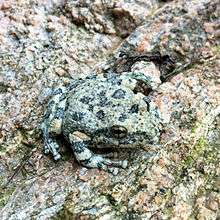California tree frog
The California tree frog or California chorus frog (Pseudacris cadaverina) is a "true" tree frog (family Hylidae) from southern California (USA) and Baja California (Mexico).[2] Until recently, the California tree frog was classified in the genus Hyla.[2][3]
| California tree frog | |
|---|---|
 | |
| Scientific classification | |
| Kingdom: | Animalia |
| Phylum: | Chordata |
| Class: | Amphibia |
| Order: | Anura |
| Family: | Hylidae |
| Genus: | Pseudacris |
| Species: | P. cadaverina |
| Binomial name | |
| Pseudacris cadaverina (Cope, 1866) | |
| Synonyms | |
|
Hyla cadaverina Cope, 1866 | |
Description
It is a cryptically colored species of tree frog, often resembling granitic stones. It is grey or light brown on its dorsum with darker blotches, and has a whitish venter. It is yellow on the undersides of its legs, groin, and lower abdomen; males of the species have a dusky-yellow throat. The California tree frog has conspicuous toe webbing and pads, and its dorsal skin is roughened and warty. It is 2.9–5 cm (1.1–2.0 in) long.[3][4]
Habitat and conservation
This species is most likely to occur along streams with abundant boulders and cobbles in their channels. Its distribution is spotty and localized. These frogs are easily handled.[4]
California tree frog is not considered threatened by IUCN: it is a relatively common species with broad distribution, and there are no major threats, except perhaps UV radiation that reduces embryonic survival.[1]
References
- Hammerson, Geoffrey; Santos-Barrera, Georgina (2004). "Pseudacris cadaverina". IUCN Red List of Threatened Species. 2004: e.T55890A11374045. doi:10.2305/IUCN.UK.2004.RLTS.T55890A11374045.en.
- Frost, Darrel R. (2013). "Pseudacris cadaverina (Cope, 1866)". Amphibian Species of the World 5.6, an Online Reference. American Museum of Natural History. Retrieved 18 September 2013.
- Hollingsworth, Bradford & Roberts, Kathy. "Pseudacris cadaverina California Treefrog". SDHMN Field Guide. San Diego Natural History Museum. Retrieved 18 September 2013.
- Fisher, Robert N. & Case, Ted J. "Pseudacris cadaverina California Treefrog". A Field Guide to the Reptiles and Amphibians of Coastal Southern California. United States Geological Survey (USGS). Retrieved 18 September 2013.
